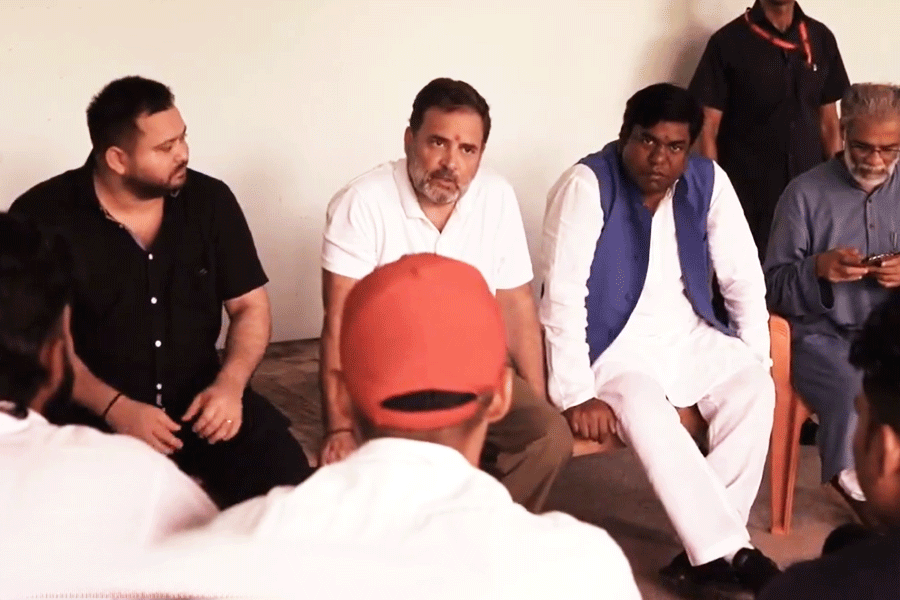Crossings
THE ROOTS of happiness run deep in this Calcutta suburb. And at the bottom of it all is a fruit - guava in the main. But also kul, jamrul, litchi, koromcha, musambi, pineapple and jackfruit. In the bele-dwaash maati - local term for the mix of sandy and clayey soil - of this subdivision of South 24-Parganas, the fruit of the farmer's toil is sweet and plentiful.

Today, Baruipur is synonymous with its guavas. The beginnings of this correlation were sown in the late 80s when the numerous scattered garden varieties of the fruit were put through a process of standardisation. A few suitable ones were retained and propagated. The two predominant varieties now are Allahabad safed and khaja.
"If you bite into a guava grown in adjoining Hooghly, Howrah or Midnapore, in all likelihood it'll be the Baruipur guava," says Rishi Krishna De, assistant director (admin) of the Department of Agriculture. The high yield crop is much in demand outside Bengal too. That is why the nurseries grow stem "columns" for export. They fetch the state crores of rupees, according to De.

In this suburban serenity, the sight of branches heavy with fruit greets the eye in all directions, interspersed with various shades of hibiscus. The fruit is tied up in little polybags - armour against squirrels and birds. Growth doesn't get hampered. On the contrary, like an obedient child, the guava swells in whatever oxygen and humidity it gets. The jacket also renders it light skinned, unblemished. The groves are given what experts call the " bahar treatment". This allows a branch to bear more flowers - thrice a year.

"No one is left wanting a livelihood," says Bishnupada Mondal, a 60-something farmer who rides a rickety two-wheeler and owns a 2.5 bigha orchard with about 200 trees. He rattles off the benefits of the guava - " Kochi peyara (unripe guava) brings back the taste in your mouth after an illness, the dansha (crunchy) one is good for the blood, and paka (ripe) peyara aids digestion and bowel movement." Also, the sweetness is permissible for blood sugar patients. It contains many more vitamins than are contained in an apple. It is the "poor man's apple", says De, who has authored a book on easily cultivable fruits.
Guavas have given Baruipur a facelift. The houses are all concrete, some brightly painted, and the lanes narrow but neat. Everyone seems well-fed, including the goats. Householders are happy to leave heaps of over-ripe and rotting guavas here and there, perhaps an effort to give back to the earth what it has given them.
For Ranjan Bairagi, whose modest hut grew into a three-room house about 10 years ago, every day of the year is harvest day. Except during the winter months, for that's Baruipur's own season of mellow fruitfulness. Then the guava ripens at leisure and is sweeter than ever. "In winter, we sell it for thrice the price," says the stocky 44-year-old. "We work like regular office-goers," quips the older Mondal, who plucks the fruit around six in the morning and reaches the market by eight. "By 10, I have sold off the entire basket, after which I buy fish and vegetables for the day... No one in my house will eat fish that is not freshly bought."
Down the years, the farmers of Baruipur have adopted new ideas and processes, often supplementing their income by growing other crops. Atheyi Gupta, assistant director, Baruipur Block, likes to call them "progressive" farmers. "They are quick to come to us whenever there is a problem - water logging or after a storm," she says. The more well-to-do have taken to organic farming - production is lower and slower, but they earn them at least thrice as much per kilo.
So much for the faithful guava trees of Baruipur. Learn to listen to the rustling of the leaves, and they may be willing to give more. Bairagi says he took a six-month jam-jelly making course but nothing came of it. "It was not very good... we need a credible authority's seal," he laments. Pulp the thought, bite into Baruipur crunch instead.
Paromita Kar











